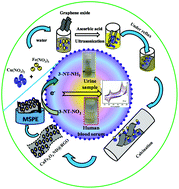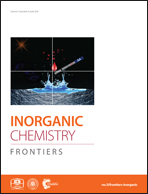Hierarchically structured CuFe2O4 ND@RGO composite for the detection of oxidative stress biomarker in biological fluids
Abstract
In this work, stable and catalytically active copper ferrite nanodots (CuFe2O4) entrapped by porous RGO nanosheets were prepared via a facile condensation process using a green reducing agent. The composite was characterized by HR-TEM, EDX, XRD, Raman, TGA, and electrochemical methods. Oxidative stress caused by the imbalance between oxidants and antioxidant defenses is implicated in many pathological conditions including age-related disorders, cancer, and cardiovascular, inflammatory, neurodegenerative and neuropsychiatric diseases. 3-Nitrotyrosine is an electrochemically active biomarker of oxidative stress; hence its electrochemical determination is useful to set up a sensitive analytical tool for oxidative stress measurement. The electrocatalytic activities of a CuFe2O4@RGO composite modified electrode toward 3-nitrotyrosine were studied in detail. A rapid, sensitive, selective and reproducible electrochemical sensing platform was developed for the detection and quantification of 3-nitrotyrosine under neutral pH conditions. Remarkably, the limit of detection was found to be 25.14 pM, which surpassed the detection limits of many existing analytical methods. The practical applicability of the method was demonstrated in human urine and blood serum samples.



 Please wait while we load your content...
Please wait while we load your content...